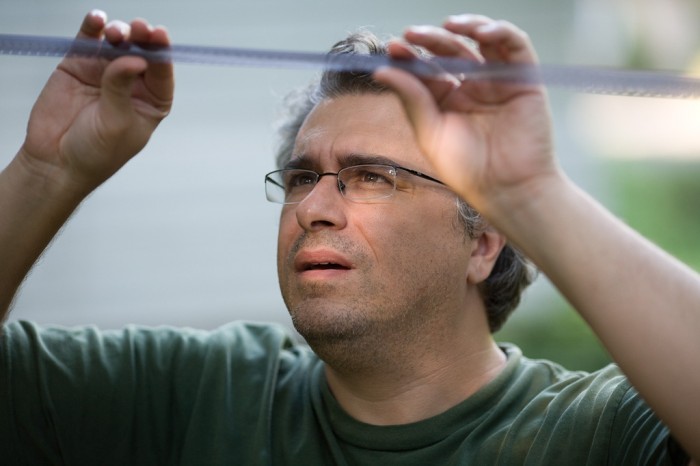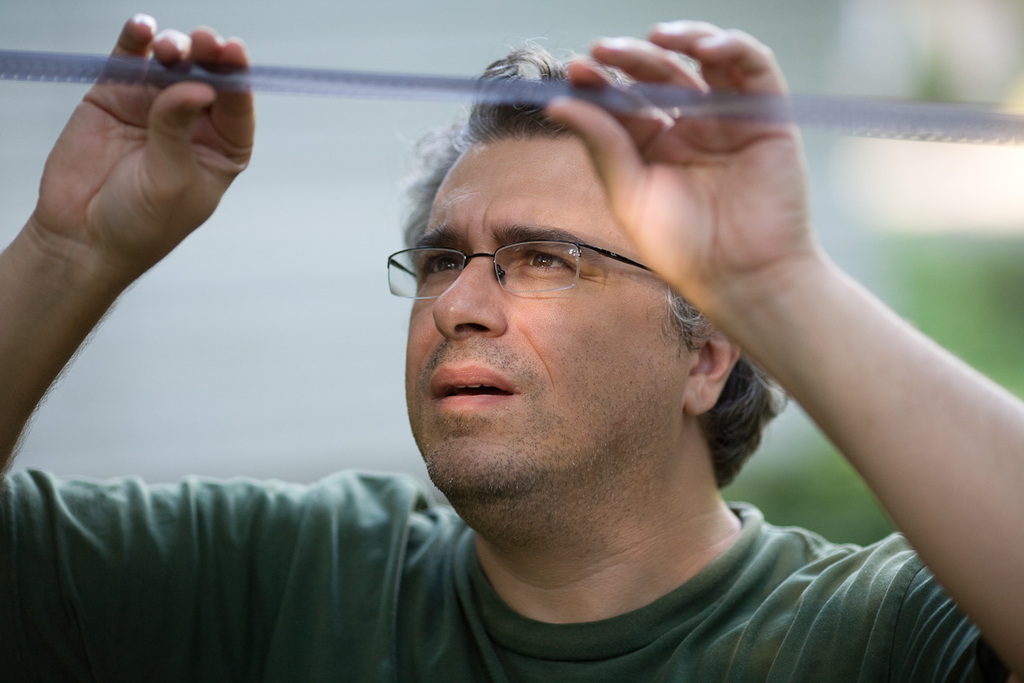Cinematographer
My friend Simon, reviewing his 16mm negatives as they hang in the back yard.
Simon’s family came for a weekend visit – and brought along a Bolex and two 100′ spools of 16mm Double-X. I added a roll of 16mm Tri-X reversal to the fun, and did some ad-hoc improvisation to develop all of it.
First up: Double-X with a pre-hardener. Kodak says to pre-harden it in SH-5 (which I can’t find) and then develop it in D-96 (which I also can’t find). I wound up developing it in ID-11 1:1 and whipped up this pre-hardener:
- 100g sodium sulfate
- 50g sodium carbonate
- 10mL gluteraldehyde
- make up to 1L
First problem: it turns out that I don’t actually have sodium sulfate in the house. So: quick trip to the auto repair store for some battery acid, and to the grocery store for some baking soda, and we whipped up the sodium sulfate. My math says that ~117g of sodium bicarbonate with as much sulfuric acid as continues to react with it should have made up the sodium sulfate that I needed (plus copius water and carbon dioxide), and that’s what I went with. (In retrospect, I could have used more of the sodium carbonate directly – but I thought I was almost out of it, so I decided to go with bicarb instead. At least it all worked without buying the Lye that I was initially planning to use.)
Ultimately I couldn’t get the pre-hardener to go in to solution (even at 90 degrees). I took what I could get – filtering it and letting it cool down to about 80 before we used it. After 10 minutes in the Morse tank it came out a bit soupy and I suspect it was too warm for the gelatin. Oh, and one of the film clamps in the tank failed, forcing us to open it up and fog the film. Ah well.
ID-11 at 1:1 for 11 minutes, stop bath, and Ilford Rapid Fixer all proceeded as normal, and there’s at least an image on the film. It’s hard to tell how good or bad it came out.
For the second roll, we skipped the pre-hardener and went right with ID-11 (at 12 minutes this time to compensate for a slight underexposure). This seemed to work just fine; I had been concerned about the gelatin coming off of the substrate (after all, that’s why Kodak recommends a pre-hardener for this film), but I saw no obvious signs of that happening.
The inversion process was also fun. Where by fun, I mean “slightly dangerous, but worked.” First developer, 11 minutes:
- 1+5 PQ Universal, 1L total
- 12g sodium thiosulfate
Washed in 0.2% EDTA solution for 2 minutes, and then hit with the bleach for 10 minutes:
- 800mL water
- 36mL of 35% sulfuric acid
- 9.5g of potassium dichromate
- made up to 1L
A quick rinse, and then the clearing bath for another 5 minutes:
- 800mL water
- 50g sodium sulfite
- make up to 1L
Now that half of the silver was dissolved, we opened up the window to the Morse tank and exposed what remained to light. We could watch the movie playing out as we rolled it past the window, not being able to make out more detail than obvious pans back and forth, but very cool nonetheless. The film was then re-developed in 1+9 PQ Universal; stopped; fixed; and washed (we found 4 tank refills, rolling the film through one direction each time, to be sufficient to clear the water coming out).
What you see here is Simon looking at the second roll of Double-X, hanging between two trees in our back yard as it dried.
I can’t wait to see some of the actual video. Someone told me that he’s a damn fine cinematographer. Oh wait, that was him. 🙂

